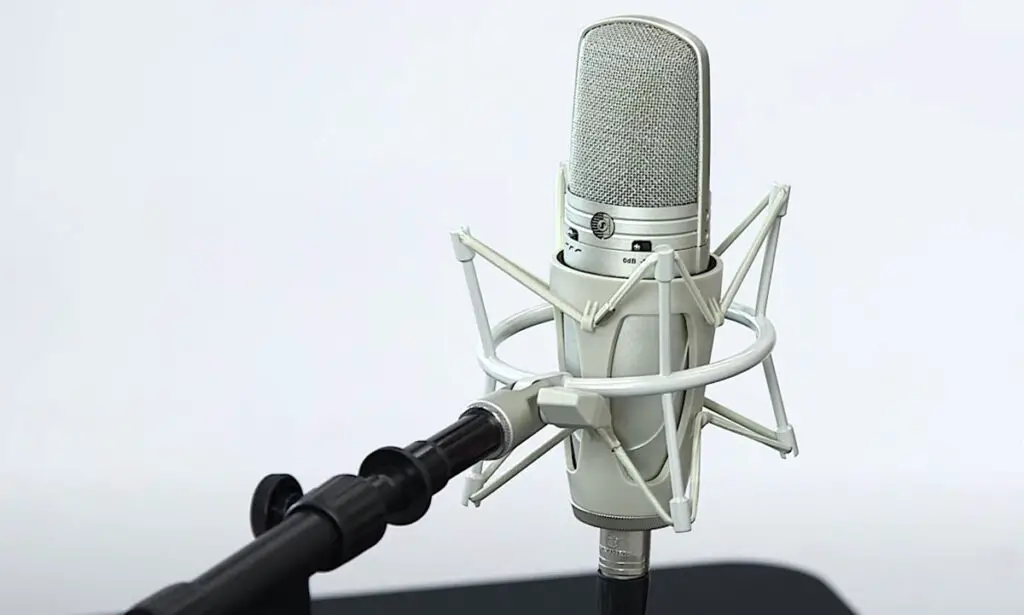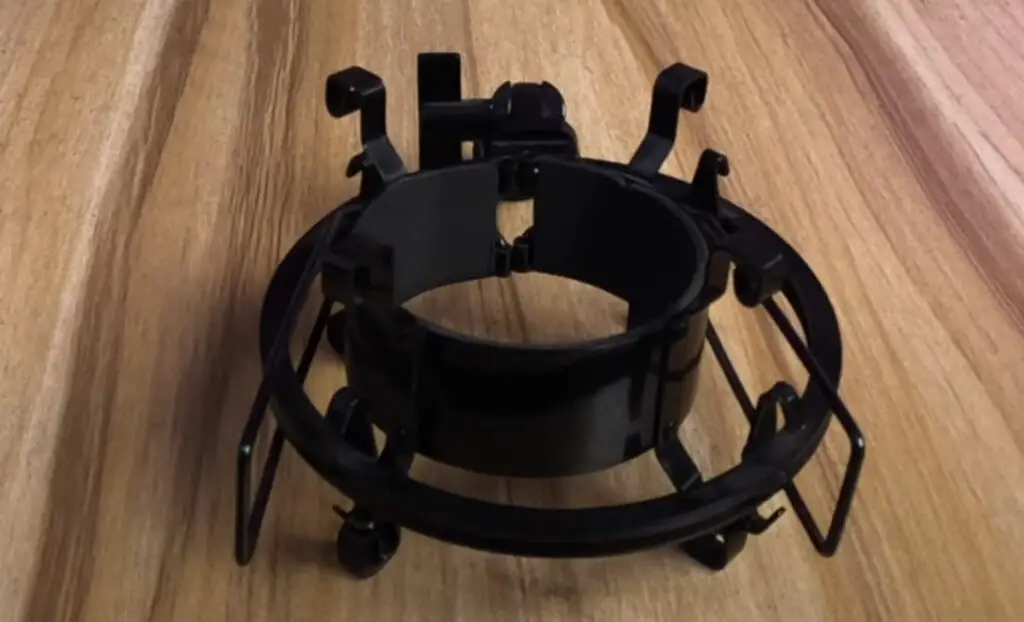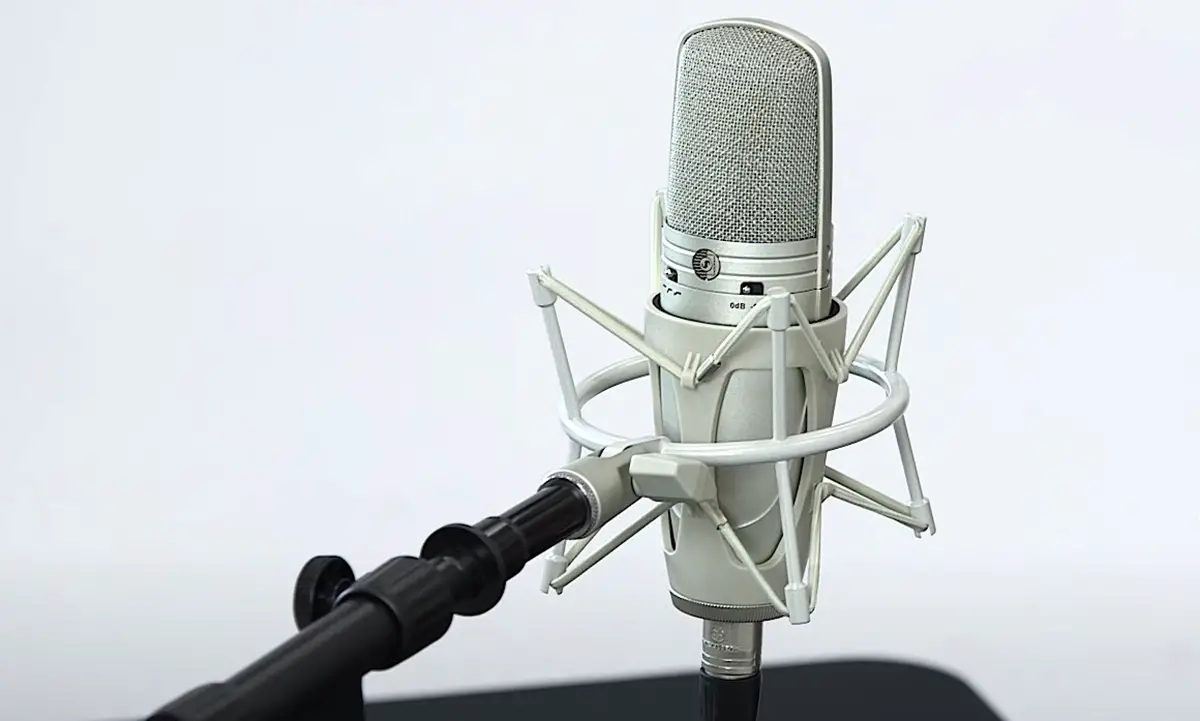In the world of audio recording, every detail matters. From the choice of microphone to the acoustics of the room, each element plays a crucial role in determining the final quality of the sound. Among these components, one often overlooked yet vital accessory is the microphone shock mount.
What does a shock mount do?
A shock mount isolates a microphone from physical vibrations and handling noise, preventing these from being picked up in the audio signal and thus improving the quality of the recording. It serves as a buffer between the microphone and its stand, absorbing vibrations before they reach the microphone.
Designed to isolate the microphone from physical vibrations and handling noise, shock mounts can drastically improve the clarity and quality of your audio recordings.
This article takes a look into the functionality of shock mounts, explores why they are particularly important for condenser microphones and provides guidance on choosing the right shock mount for your specific needs.
Whether you’re a budding podcaster, a professional musician, or an audio engineer, understanding the value of a good shock mount could be the key to elevating your sound to the next level.

What Does a Microphone Shock Mount Do?
A microphone shock mount is a device that is used to hold a microphone and isolate it from physical vibrations that can produce unwanted noise in the audio signal. It serves two main purposes:
- Vibration Isolation: The shock mount is designed with elastic materials (like rubber bands or other similar materials) that can absorb vibrations before they reach the microphone. For instance, if your microphone is on a desk or a floor stand, it can pick up vibrations from people walking around, tapping on the desk, or other such movements. These vibrations can create low-frequency rumbles in your audio, which a shock mount can help prevent.
- Noise Reduction: In addition to absorbing physical vibrations, shock mounts can also reduce handling noise. For example, if you’re adjusting the position of the microphone while it’s live, a shock mount can help isolate the microphone from these noises.
Using a shock mount can therefore greatly improve the quality of your audio recordings by reducing unwanted noise and vibrations.
Do I Really Need a Shock Mount?
Whether you need a shock mount depends on several factors related to your recording setup and environment:
- Your Recording Environment: If your recording environment is prone to vibrations (e.g., from foot traffic, nearby machinery, or even heavy typing on the same desk), a shock mount can help eliminate these unwanted noises.
- Microphone Handling: If you need to adjust your microphone’s position frequently during recording or if the microphone might be bumped or moved, a shock mount can help reduce handling noise.
- Microphone Type: Some microphones, particularly large-diaphragm condenser microphones, are very sensitive to vibrations and handling noise. For these types of microphones, a shock mount is often recommended.
- Professional Quality Recordings: If you are aiming for professional-level sound quality, a shock mount can help by reducing unwanted noise and interference.
If you’re just doing casual recording or podcasting in a quiet environment and you are using a dynamic microphone in a fixed position where it won’t be disturbed, you may not need a shock mount.
It ultimately comes down to the specifics of your situation and the quality of audio you’re aiming to achieve.
Do You Need A Shock Mount For A Dynamic Microphone?
Dynamic microphones are generally more robust and less sensitive to physical vibrations and handling noise compared to condenser microphones, so they often don’t require a shock mount for casual or live usage.
This is why you often see dynamic microphones being used in handheld situations like live concerts or interviews without a shock mount.
However, even though dynamic microphones are less susceptible to vibration noise, they’re not entirely immune. If you’re recording in an environment where there’s a lot of mechanical noise or vibrations (for example, near heavy machinery or on a stage with a lot of movement), a shock mount could still be beneficial.
If you’re aiming for a very high-quality recording with a dynamic microphone, a shock mount can help ensure that you’re capturing the cleanest signal possible.
So, while a shock mount isn’t typically necessary for dynamic microphones, there are still scenarios where using one could be beneficial. As I’ve said, It ultimately depends on your specific recording situation and the level of audio quality you’re aiming for.
Why Do Condenser Mics Need Shock Mounts?
Condenser microphones are generally more sensitive than dynamic microphones, making them more susceptible to unwanted noise and vibrations. This sensitivity is partly due to the way condenser microphones work.
A condenser microphone operates using a capacitor (or condenser), where one plate of the capacitor vibrates in response to sound waves, changing the distance between the two plates. This change in the distance changes the capacitance, and this change can be converted into an electrical signal that corresponds to the sound.
Due to this design, condenser microphones are great for capturing subtle details in sound, making them popular in studio settings for vocals, acoustic instruments, and other sources where detail and clarity are important.
The same sensitivity that allows them to capture these details also makes them prone to picking up unwanted noise from vibrations. This could include vibrations traveling up the microphone stand from the floor, vibrations from handling the microphone, or even the vibrations from a loud bass sound in the same room.
A shock mount helps to isolate the microphone from these vibrations, providing a buffer of sorts between the microphone and the stand. The elastic material of the shock mount absorbs the vibrations, preventing them from reaching the microphone and being picked up in the audio signal.

What Does a Shock Mount Connect To?
A shock mount typically connects to a microphone stand or a boom arm. The specific design of the connection can vary, but most shock mounts use a threaded connector that screws onto the stand or arm.
One end of the shock mount has a threaded hole that matches the threads on the stand or arm. You simply screw the shock mount onto the stand or arm until it’s secure.
The other end of the shock mount is where the microphone goes. This usually involves some sort of clamp or cradle that holds the microphone securely while still allowing it to be isolated from vibrations by the shock mount’s elastic material.
Some shock mounts also have an adapter that allows them to be connected to stands or arms with different thread sizes. This can be useful if you have a stand or arm that doesn’t match the thread size of your shock mount.
Do Shock Mounts Fit All Mics?
Shock mounts do not universally fit all microphones. Shock mounts are typically designed to fit a specific size or range of sizes of microphones, and some are designed to fit specific models of microphones.
The primary factors that determine if a shock mount will fit a particular microphone are the diameter of the microphone and the design of the mount itself. For example, some shock mounts are designed with a specific diameter in mind, and they use elastic bands or other materials to hold the microphone in place.
Some high-end or uniquely-shaped microphones have custom shock mounts made specifically for them. These custom mounts may not fit other microphones, and likewise, standard shock mounts may not fit these unique microphones.
Therefore, when purchasing a shock mount, it’s important to check that it’s compatible with your specific microphone. This information should be available from the manufacturer or seller of the shock mount.
Conclusion
In the pursuit of pristine audio quality, the role of a shock mount should never be underestimated. While it may seem like a small and inconspicuous part of your recording setup, a shock mount serves the crucial function of isolating your microphone from external vibrations and handling noise, ensuring that your recordings remain clean, clear, and professional.
Whether you’re using a sensitive condenser microphone in a studio setting or a rugged dynamic microphone in a live environment, a well-matched shock mount can significantly enhance your audio quality.
Every element of your audio setup contributes to the final sound, and paying attention to these details can make the difference between a good recording and a great one.
As you continue your journey in audio recording, let the shock mount be a reminder of the importance of nuance, precision, and the pursuit of sonic excellence.


